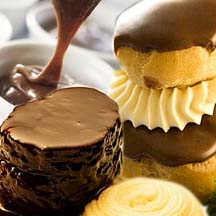In the Market for Food Writing?
by Jill Earl This year, one of the markets I’m pursuing is food writing. In the course of research, I’ve found a couple of markets that have whet my appetite, which I share below. First up is Gastronomica, published quarterly and billing itself as ‘the journal of food and culture’. Their content encompasses the myriad ways food touches our lives, ranging from historical articles to interviews to essays. In the Fall 2009 issue, I was intrigued by Andrea Broomfield’s examination on how even the meals on the ill-fated Titanic fell along class lines. I traveled along with photographer Ahahita Avalos viewing images of ‘Al Mercado’, the Mercado Pino Suarez, the central market in Villahermosa, Mexico. And Adela (Mary) Blay-Brody shares memories of the role of hot peppers in Ghanaian cuisine and offers a rich pepper soup to top off her essay, ‘Rx. Pepper Soup’. Articles should generally not exceed 7,000 words. See submissions details at their site online. More creative offerings are found in Alimentum, ‘the literature of food’. Issues are released yearly in the winter and spring, and they accept fiction, nonfiction, poetry and book reviews. The Winter 2009 issue featured an enlightened interview with Alan Richman, whose work appeared in magazines including Conte Nast Traveler, Bon Appetit and GQ, and is Dean of Food Journalism at The French Cullnary Institute of New York. ‘Useful Kitchen Knots’ was a hilarious piece complete with sketches that gave a new tongue-in-cheek perspective on knots. And for reviews of the latest food-oriented books, click on the ‘Goodies’ heading online. The submission period runs from September to March and more information can be found at their site. So if you’re in the market to pursue food writing, give these journals a closer look. They just might be the recipe needed for a new direction in your writing this year. Labels: food writing, Jill Earl, writing, writing markets
Finding a Recipe for Successful Food Writing
by LuAnn SchindlerA friend of mine from New York writes about the NYC food scene for several local newspapers and online sites. This past week, she introduced me to a social networking site for foodies: Foodbuzz. Granted, I've only been on the site a few times, but if you are interested in foodwriting of all kinds, including restaurant reviews, recipes, and product news, Foodbuzz appears to be a gold mine of information. Today, I learned about Sake (Japanese rice wine) and then I found a recipe for waffles that I plan to try in the morning. It's a good reason to use the new waffle ironmy oldest daughter gave me for Christmas! (And yes, the waffle iron was on my wish list.) Labels: food writing, Foodbuzz
A Recipe for Writing
by LuAnn Schindler I admit that I enjoy food. Developing a new recipe, testing it in my kitchen, preparing it for dinner and awaiting my husband's response provide fun, trial and error and a pleasurable dining experience at our house. Sure, some of you might tell me I need a new life, but the truth is, I inherited the "good cook" genetics from both sides of my DNA strand. And I've used my cooking talent to my writing advantage. My first experience with food writing was about five years ago when I entered a pizza recipe contest. I'll be honest. I'd never made the pizza recipe I submitted. I saw the ad for the competition, looked at previous winners, closed my eyes and envisioned what would be a good pizza. I had plenty of past experience tossing the pizza pie; I managed a pizza place when I was in college. I made pizza often when I was growing up and when I married and had kids. Surely I could come up with a good recipe. So I wrote a recipe for the pizza I saw before my eyes and submitted it. Six months later I received a certified letter from the sponsoring company informing me that I won the national contest! I would not recommend this type of food writing to anyone! I consider it a lucky fluke that my creation was crowned champ. Now, I take my time when writing about food. As with all types of writing, the first step is coming up with the story idea. Next, you knead and mold the idea into a delectable story. And the good thing with food writing: there are so many different ways to present information. If you're interested in food writing, consider these options: - Recipes. Have a killer recipe for salsa? Many magazines and newspapers look for features based on a food, theme or ingredient. Along with a traditional salsa recipe, add a recipe for a fruit-based salsa or a bean-based spread. Most stories of this nature feature an introduction with three to five recipes.
- News. Think about the salmonella outbreak from this year. First, tomatoes were the cause. Eventually, peppers took the heat. Interview experts and write a news story based on our findings. When I first heard about the salmonella outbreak in March, I contacted my editor at a regional magazine and pitched a feature based on when I had salmonella a year ago.
- Interviews. New restaurant in town? Looking for a personal chef? Interview these people and turn their responses into a profile.
- Travel guides. Heading somewhere on vacation? Take note of restaurants, food trends, drink specials and submit to travel magazines.
- How-To. Readers are always looking for a more effective or efficient way to complete a project. Cooking isn't any different. Pitch a how-to article based on anything kitchen related: choosing new cookware, sharpening knives, selecting fresh produce. One of my specialties is cheesecake. No, not the boxed kind. I'm talking real cheesecake with cream cheese, sour cream, eggs, sugar. The kind that doesn't add any weight to your hips. :) I wrote a quick how-to avoid cracking the top of the cheesecake and sold it to a cooking website. I got paid $50 for a common sense tip that I use all the time. Plus, it only took me a half hour to write it.
- Human interest. O regional newspaper recently featured a group of volunteers who run the soup kitchen at a church in the metro area. The story showed how you can make something edible out of nothing, and how these volunteers are building a connection with the homeless who eat lunch there. It was an amazing vignette!
- Food history. This is one of my favorites since it combines two things I like: history and food. I wrote a history of pecans and included five recipes for a magazine a few years ago.
- Cookbook reviews. Everyone has a cookbook that they turn to often. Mine came from my godfather when I got married. He's a church pastor and it was from his church. It's weathered and stained, but I use it daily. Sometimes I add ingredients to a recipe to fit my family, but it's still a good source.
These are just a few ideas to get your creative juices flowing in the kitchen and on pen and paper! Labels: food writing, LuAnn Schindler
Got Writer's Block? Go Dish!
 Ever gone shopping while hungry? Ever gone shopping while hungry? You go to the grocery store for a couple of things and end up with a shopping cart filled with chocolate desserts, salty snacks, and a hefty receipt to match. I hate to admit it, but I fall into this trap all the time. But what about when your writing is as empty as your stomach? You stare at the blank page and blinking cursor, and know that you need to fill it with delicious prose; yet, your words fail you. Why not try adding some culinary creativity to your story? Here’s an excerpt from The Writer’s Block that may just get your fingers tapping: We pause to eat at least three times a day—and yet so many writers neglect the powerful sense of taste. One of the most memorable chapters in Herman Melville’s Moby Dick is simply called “Chowder,” in which Ishmael enjoys a steaming bowl of stew: “It was made of small juicy clams, scarcely bigger than hazel nuts, mixed with pounded ship biscuit, and salted pork cut up into little flakes; the whole enriched with butter, and plentifully seasoned with pepper and salt.” More recently, Laura Esquivel had an international bestseller with Like Water for Chocolate, a novel that includes recipes for Quail in Rose Petal Sauce, Northern-style Chorizo, and Cream Fritters. Each chapter begins with a list of ingredients and notes on preparation, which Esquivel weaves seamlessly into the narrative. And Charles Frazier’s Cold Mountain is practically a primer in country cooking; his characters slaughter hogs, churn apple butter, and cook savory chicken stew. Prompt: Write a story or scene that centers around an extraordinary meal. The food itself can be quite simple—even as simple as a TV dinner—but the meal should have an important and lasting significance to the characters. Food is a universal language—so, go dish!Labels: food writing, taste, writer's block, writing prompt
|












